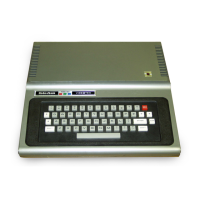Explanation
of
the
program:
Line
lee
The array R contains the result and the array S$ contains the most recent
operator at level
L.
The program begins at level 0. Levels are analogous to
expressions within parentheses. The level is increased by one as a left parenthesis
is
encountered, and decreased by one as a right parenthesis is encountered.
Line
118 A subroutine is used to get a character from the keyboard. The character
is
returned in the string variable C$.
Lines
128·
138 If the character returned
is
a decimal point (.)
or
a digit (0 - 9), then
a subroutine (GOSUB 600) is used to build the rest
of
the number. The value
of
the
number is returned in the numeric variable NU. Another subroutine (GOSUB 800)
is
used to compute the result
of
applying the operator to the previous result (if any) and
the current value NU. The result is stored
in
the appropriate level
of
the array R.
Line
148
If
a right parenthesis is typed, the value at the current level is combined
with the value at the previous level. This is why the operator
at
the previous level was
saved in the S$ array.
Lines
158
•
185
If
an arithmetic operator is typed, it is saved in the S$ array.
Execution then returns to line 110 to get the next character.
Line
198
If
a left parenthesis is typed, the level is increased by one, the result at the
new level
is
initialized to zero, and the operator
is
assumed to be addition. Execution
then returns to line 110 to get the next character.
Line
2ee
If
an equals sign
(=)
is typed, then the answer, which is the result at the
current level, is displayed. The level is initialized to zero and execution jumps to line
100 to begin a new problem.
Line
265
If
(ENTER)
is pressed, then the message CANCELED is displayed and a new
problem is begun.
Line
218
If
any other key is inadvertently typed, it must be a mistake, and therefore
does nothing to the calculation. Execution jumps back to line 110 to get the next
character.
Lines 588 - 538 A
REMark
statement
is
used for documentation
in
line 500. A REM
statement is ignored by the BASIC language interpreter and
is
used to insert
explanatory comments for the convenience
of
the programmer. This subroutine
continually scans the keyboard until a key is pressed. The character is stored
in
the
string variable C$ and displayed before returning. The INKEY$ function returns a null
string
("")
if
no key is pressed.
Lines 688 •
728
This subroutine builds a number with
or
without a decimal point.
If
the number has a decimal point, the subroutine first builds the part
of
the number to
the left
of
the decimal point, and then builds the part
of
the number to the right
of
the
decimal point. Since the characters are originally in string form (C$), the VAL
function
is
used to convert to numeric form. The number is assumed to be completed
when any character other than a digit or a decimal point is typed.
Lines 888 • 868 This subroutine computes the result at the current level. The
appropriate operator (
+,
-,
*,
or
A)
is applied and the result stored in the R array.
187

